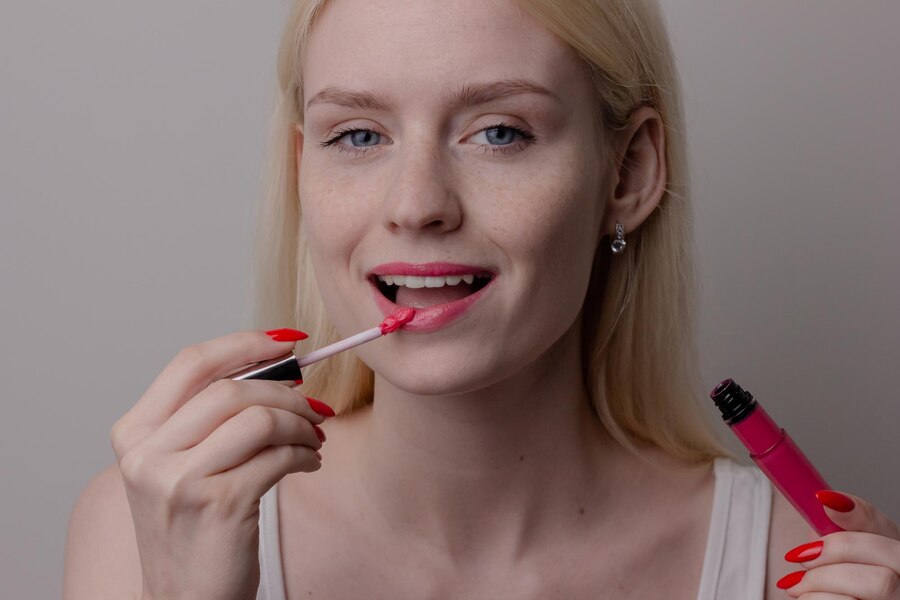How to Apply Lip Gloss Without It Feeling Sticky

Lip gloss is a popular beauty product that adds shine to the lips, but many people avoid it because of the sticky and uncomfortable texture. If you have ever struggled with your hair sticking to your lips or a thick, heavy feeling, you are not alone. However, there are ways to apply lip gloss properly so that it feels lightweight and comfortable.
1. Why Does Lip Gloss Feel Sticky?
Many lip gloss formulas are designed to provide a long-lasting shine, but some ingredients can make them feel heavy and tacky. Understanding the causes of stickiness can help you choose the right products and apply them in a way that feels comfortable.
Common Causes of Sticky Lip Gloss:
One of the main reasons lip gloss feels sticky is its texture. Many lip glosses contain thickening agents like petroleum jelly, wax, or heavy oils that make them adhere to the lips. While these ingredients help gloss last longer, they also contribute to the sticky feeling.
Applying too much lip gloss at once can also cause stickiness. When multiple layers of gloss build up on the lips, it creates a thick and heavy texture that feels uncomfortable.
Another factor is dry lips. If your lips are rough or flaky, lip gloss may not spread evenly, leading to an uneven and tacky finish. Humidity and weather conditions can also affect how lip gloss feels, making it feel thicker in hot or humid environments.
2. Start with Smooth and Hydrated Lips
Lip gloss applies best on smooth and well-moisturized lips. If your lips are dry, chapped, or flaky, the gloss will cling to rough patches, making it feel uneven and sticky. That’s why it’s important to understand the difference between lip balm vs gloss, as using the right product beforehand can greatly improve how your gloss looks and feels. Prepping your lips before applying gloss helps create a smoother and more comfortable finish.
How to Prep Your Lips:
Exfoliation is an important step in lip care. Gently removing dead skin cells ensures that lip products go on evenly. You can exfoliate your lips using a lip scrub or a soft toothbrush. Rub the scrub or brush in circular motions to remove dryness.
Hydration is also key. Apply a thin layer of lip balm or lip oil to keep your lips soft and prevent dryness. Avoid thick or waxy balms, as they can interfere with the gloss application.
If your lips feel too oily after applying balm, blot them lightly with a tissue before applying lip gloss. This helps prevent the gloss from becoming too slippery.
3. Choose the Right Lip Gloss Formula
The formula of your lip gloss plays a major role in how it feels on your lips. Some glosses are specifically designed to be non-sticky and lightweight. Whether you prefer a glossy or matte finish, choosing the right formula can help you achieve a comfortable and smooth look.
What to Look for in a Non-Sticky Lip Gloss:
Oil-based glosses tend to be less sticky than traditional thick glosses. Look for ingredients like jojoba oil, coconut oil, or argan oil, as they provide shine without the tacky texture.
Hydrating glosses with ingredients such as hyaluronic acid, vitamin E, or aloe vera help keep lips smooth and moisturized. These formulas prevent dryness and make the gloss feel more comfortable.
Gel-based lip glosses are also a good option because they provide shine without feeling heavy. Unlike thick wax-based glosses, gel formulas spread evenly and feel lightweight on the lips.
Tinted lip oils are another alternative. They provide a glossy finish with added hydration, making them a great choice for those who dislike traditional gloss textures.
Avoid thick, high-shine glosses with heavy waxes, as these are more likely to feel sticky.
4. Apply a Lip Liner or Matte Lipstick First
Using a base product before applying lip gloss can help reduce stickiness and make the gloss last longer. A lip liner or matte lipstick provides a smooth surface for the gloss to adhere to, preventing it from feeling thick or uneven.
How to Layer for a Smooth Finish:
Lip liner helps define your lips and keeps the gloss from spreading outside the lip lines. It also provides a slightly dry texture, which helps absorb excess gloss.
Applying a thin layer of matte lipstick before gloss creates a grip for the gloss to stick to. This prevents the gloss from moving around too much and feeling slippery.
After applying lip liner or matte lipstick, add a small amount of gloss to the centre of your lips. Use a lip brush or fingertip to spread it evenly without overloading your lips with too much product.
5. Use a Small Amount of Lip Gloss
One of the biggest mistakes people make when applying lip gloss is using too much. Thick layers of gloss can create a heavy and sticky texture, making it feel uncomfortable.
Best Way to Apply Lip Gloss:
Instead of swiping multiple layers of gloss across your lips, start with a small amount. Dab a small dot of gloss in the centre of your lips and use your finger or a brush to spread it evenly.
Avoid applying gloss to the corners of your lips. This area tends to collect excess product, leading to a sticky and uneven finish.
Using a thin layer of gloss not only prevents stickiness but also creates a more natural, comfortable look.
6. Set Your Lip Gloss for a Comfortable Finish
If your lip gloss still feels sticky, you can use a few techniques to make it feel lighter.
Ways to Reduce Stickiness:
Blotting your lips with a tissue helps remove excess gloss, making it feel less thick. Simply press a tissue gently over your lips and let it absorb any extra product.
Applying a small amount of translucent powder over your lips can also help. Use a fluffy brush to dust a light layer of powder over the gloss to soften its texture. This method helps create a more natural, non-sticky finish.
A light mist of setting spray can also help lock the gloss in place. Setting sprays designed for makeup helps control excess shine and prevent gloss from feeling too slippery.
7. Reapply Lip Gloss Correctly
Throughout the day, lip gloss may wear off, but adding multiple layers over old gloss can create a thick and sticky buildup.
How to Reapply Without Stickiness:
Before reapplying, remove the old gloss with a tissue or a gentle wipe. This prevents layers from becoming too thick.
Apply a fresh, thin coat instead of layering too much gloss at once. If your lips feel dry, reapply a small amount of lip balm before adding gloss.
Tinted lip oils or sheer glosses are good alternatives for touch-ups, as they provide shine without adding too much weight to your lips.
8. Consider Non-Sticky Lip Gloss Alternatives
If you still find traditional lip gloss uncomfortable, other options provide shine without the sticky texture.
Best Non-Sticky Lip Gloss Alternatives:
Lip oils are a great alternative because they provide a glossy effect while keeping lips hydrated. Unlike traditional glosses, lip oils absorb into the skin, reducing the chance of stickiness.
Glossy lip balms offer a natural shine while providing moisture. They are lightweight and comfortable, making them a good choice for everyday wear.
Satin-finish lipsticks provide a glossy look without the heavy feel of a traditional gloss. These lipsticks offer shine and hydration without the tacky texture.
Final Thoughts
Lip gloss does not have to feel sticky or uncomfortable. By choosing the right formula, applying it correctly, and using a minimal amount, you can achieve a glossy and lightweight look.
The key to a non-sticky finish is to start with smooth, hydrated lips, use a lip liner or matte lipstick as a base, and apply gloss in thin layers. Setting your gloss with a tissue or translucent powder can also help control excess shine and prevent a heavy texture.
FAQS
How do I make my lip gloss less sticky?
To reduce stickiness, try applying a thin layer of lip balm before your gloss. You can also choose non-sticky formulas or lightly dust translucent powder over your lips to set the gloss.
Why does lip gloss feel sticky?
Lip gloss contains thickening agents like waxes and oils that create a shiny, long-lasting finish. Stickiness can also depend on the formula—some glosses use heavier ingredients for extra hydration and shine.
How do you apply lip gloss smoothly?
For a smooth application, exfoliate your lips first and apply a hydrating lip balm. Use the gloss applicator or a lip brush for even coverage, starting from the center and blending outward.
What helps lip gloss stay on?
To make lip gloss last longer, use a lip liner or a matte lipstick as a base. Blot lightly after application and reapply a thin layer for a fresh look without excess buildup.
Are all lip glosses sticky?
No, not all lip glosses are sticky. Many brands offer lightweight, non-sticky formulas with hydrating ingredients for a comfortable, glossy finish.
